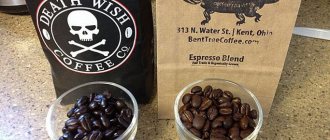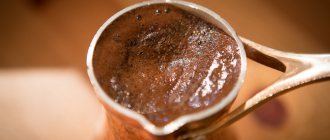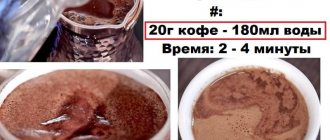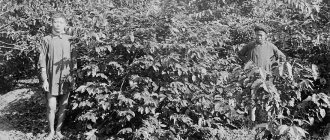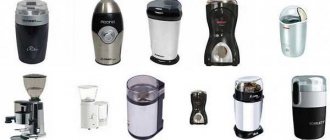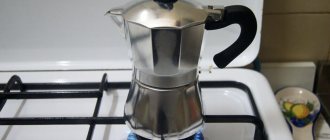How did Vietnamese coffee come about?
With the introduction of coffee culture to Vietnam by French missionaries in 1857, a new era for the country began. Coffee is tightly and deeply woven into the social and economic spheres of modern Vietnam. Currently, Vietnam ranks confidently in second place after Brazil in terms of coffee export volumes. The country, which previously did not know about coffee, made it its national drink in a fairly short period.
Vietnamese coffee, combining favorable climatic conditions coupled with fertile soils, French roasting, and introducing a bit of traditional Vietnamese originality, has conquered not only the Vietnamese themselves, but also the coffee world.
The Vietnamese, before the advent of coffee trees, preferred tea. And with the advent of coffee, the leaves of coffee trees were first brewed. And later they noticed the invigorating effect of coffee berries, learned to roast them and, at first, just hold them in their mouth. Later, the culture came to grind beans and prepare Vietnamese coffee following the example of the French.
Vietnamese coffee is prepared using the filtered method using traditional fins (press filters) for brewing coffee, the ancestors of which are disposable French filters.
Vietnamese coffee is famous for its variety of flavors and richness. And what distinguishes it from more European coffee is that the taste of Vietnamese coffee is unforgettable!
Where to buy Vietnamese coffee
When you return home, you will want to enjoy your favorite taste of Vietnamese coffee in the morning, so buy several kilograms during your trip. 100 g of Vietnamese coffee is enough for a week, provided that two people drink a cup of hot drink every morning. Good varieties in Vietnam cost only $5-10 per 500 g. If you are vacationing in Nha Trang or neighboring cities, it is best to buy coffee where it is grown: in Dalat or Dak Lak province. Prices there are lower than in tourist areas, and the chance of buying a fake is extremely low. It is best to buy the product in specialized stores (for example, La Viet Coffee in Dalat) and in local markets - tourist shops sometimes sell cheap varieties of coffee under the guise of expensive ones or add wood shavings to the ground beans. Excursion programs around Dalat and Dak Lak often include tasting of various types of coffee. Before it, tourists are usually shown how to brew coffee using a press filter, and after that they are offered to buy coffee beans of the variety they like. Keep in mind that coffee is sold at a high premium on excursions.
In Russia and other CIS countries, Vietnamese coffee can be bought in online stores or elite coffee boutiques, and prices for the product are 3-5 times higher than in Vietnam. A press filter can also be brought back from travel. In Vietnamese markets, this device can be bought for 15,000-50,000 VND (40-125 rubles). Prices in Russian specialized stores start from 250 rubles.
Where does condensed milk come from in Vietnamese coffee?
There are at least three theories about the appearance of condensed milk in Vietnamese coffee:
1. French - The French, who brought coffee culture with them to Vietnam, found that obtaining and storing fresh milk, especially with intermittent or complete lack of electrification in some areas, was difficult to live with. In this sense, canned condensed milk completely solved the problem. For French paradise, all that remained was to teach the Vietnamese how to cook baguettes and croissants. Today, the famous coffee capital - the city of Dalat in Vietnam - is a small Europe. It is distinguished by both the French style of construction and French delicacies - desserts, crispy baguettes, and even French frog legs =)
By the way, the French brought to Vietnam not only coffee, but also a drip press filter - a fin for brewing coffee. You can learn about the benefits of filtered coffee in the article “Filtered Coffee.”
2. Russian - According to one version, the USSR supplied humanitarian aid to Vietnam with condensed milk, which the Vietnamese fell in love with and became a successful tandem with traditionally dark French roast coffee.
3. American - According to another version, condensed milk appeared among the Vietnamese during the period of US military expansion. The Vietnamese tried condensed milk from the rations of captured American soldiers and liked it.
Be that as it may, one thing is certain - Vietnamese strong coffee goes well with condensed milk. Sweet condensed milk adds smoothness and creaminess to rich Vietnamese coffee. This coffee in Hanoi is the best quick breakfast, complemented only by a steamed rice bun.
What condensed milk is suitable for Vietnamese coffee?
In Vietnam, condensed milk of plant origin is more common. Typically coconut. It is important to note that such condensed milk does not have the cloying smell of coconut and is practically indistinguishable in taste from condensed milk made from whole milk of animal origin.
Condensed milk with animal cream became widespread in Vietnam during the period of development of trade relations with the USSR. They say that the Vietnamese fell in love with GOST condensed milk, but it is extremely rare on the shelves of ordinary supermarkets.
In addition to canned condensed milk, dry coconut cream is widely used in cooking in Vietnam. You can quickly make improvised condensed milk from them by dissolving dry vegetable cream in a small amount of water.
Benefits of Condensed Milk from Dry Coconut Cream
:
- Low calorie content - coconut cream itself is quite sweet due to the natural sugars it contains; additional sugar should only be added to those with an avid sweet tooth;
- Vietnamese coffee with condensed milk from coconut cream is the same coffee with milk for weight loss;
- Does not require storage in the refrigerator - dry coconut cream can be stored at room temperature without loss of taste and quality properties;
- Suitable for people with intolerance to cow's milk protein and animal products.
Besides all that, dry coconut cream is simply delicious!
Benefits of brewing coffee in Finland
Why do Vietnamese people prefer to brew coffee using the drip method using a traditional coffee fin? This method has a number of undoubted advantages:
- Allows you to brew any coffee, including those prepared in a traditional or original way, caramelized, with specific natural additives;
- Does not require electricity;
- Coffee prepared in Fin is richer and more aromatic;
- Filter coffee is healthier;
- Brewing in a fin is also a meditative process, in which you can immerse yourself while watching the process of preparing coffee, slowly dripping into a glass.
Drink recipe with condensed milk
You will get a more refined coffee if you brew it with the addition of condensed milk. The highlight of this recipe is that the drink is carefully poured into the condensed milk without mixing the ingredients.
Ingredients:
- Two teaspoons of ground grains;
- A few tablespoons of condensed milk;
- One hundred milliliters of boiling water.
Cooking method:
- Pour condensed milk into a cup, place a press filter on top and wait for the drink to brew.
- When it's ready, remove the filter.
- If you brew it in a transparent glass container, you will see a clear line between the white milk and the black drink.
- Now you can mix everything and enjoy delicious sweet Vietnamese coffee.
- You can vary this recipe by adding ice cubes at the end.
Enjoy your coffee!
What kind of coffee is suitable for cooking in Finland?
To prepare coffee in Finland, you should give preference to medium-ground coffee. Finely ground coffee is more suitable for cooking in a Turk, and it can simply clog the perforated filter. If you use coarsely ground coffee to make coffee in Finland, the taste will be less intense and the drink will be less aromatic. But this option is liked by those who prefer more European tastes of coffee and a lower density of the drink.
Vietnamese coffee options
Many people think that Vietnamese coffee is exclusively hot coffee with condensed milk. This is not entirely true. Vietnamese coffee has variations in preparation depending on the region and taste preferences.
Step-by-step recipe for making Vietnamese coffee (cà phê đen - black coffee)
Despite the strength and rich taste of Vietnamese coffee, it has many adherents in its pure form - without additives.
Vietnamese coffee is always prepared using the traditional drip method using a coffee fin, which is a cup with a perforated bottom and a press installed inside. This filter is simply placed on a cup or glass, from which you can then drink freshly prepared coffee. Although it is customary for the Vietnamese to prepare coffee in large portions at once for the whole day.
Vietnamese iced coffee latte with tapioca
Ingredients:
- Tapioca (can be replaced with regular starch) 100 g
- Ground coffee 30 gr
- Water 625 ml
- Brown sugar 2 tbsp. l.
- Condensed milk 85 ml
- Ice 2 cups. (200 ml)
- Cream 125 ml
Cooking method:
- Place tapioca balls into boiling water.
- Cook for 15 minutes.
- Place in a colander or sieve and allow excess liquid to drain.
- Rinse in cold water.
- Place in a separate bowl with a minimum of water to cool.
- Water is needed to prevent the tapioca from sticking together.
- In another bowl, boil water again.
- Add coffee (ground) and let simmer over low heat for 10 minutes.
- Add sugar and condensed milk to the coffee liquid.
- Stir and refrigerate for 10 minutes.
- Place tapioca (2 tablespoons) at the bottom of the glasses and cover with ice cubes.
- Pour coffee almost to the brim of the glass, and pour cream on top.
- Beauty and yummy.
- Let's try and enjoy.
Enjoy your coffee!
The basic step-by-step recipe for making Vietnamese coffee is quite simple.
Ingredients and tools for Vietnamese coffee:
- Vietnamese medium ground coffee
- Hot water (92-950C)
- Traditional Vietnamese fin (French filter)
- Favorite cup
Before cooking, rinse the cup and fin with boiling water to warm up.
Step 1: Use boiling water to rinse the coffee filter and rinse the cup to reduce heat absorption by the utensil when brewing coffee. This way, the coffee will expand evenly and impart flavor and aroma to the drink.
Step 2: Pour 3 teaspoons of ground coffee (about 25 grams) into the filter and spread evenly over the surface of the filter.
Step 3: Place an internal press into the fin (screw or press with a regular perforated one - depending on the model of the fin). It is important to press the coffee not too lightly (this will cause the water to pass through the coffee too quickly and it will turn out unsaturated) and not too hard (the coffee will take too long to cook). The optimal pressure is at which the liquid passes through the filter at a speed of 1-2 drops per second. After a couple of experiments, you will understand exactly what pressure is sufficient.
Step 4: Place the fin on the cup, slowly and evenly pour hot water (92-950C) over the surface of the internal filter pressing the coffee into the filter, filling it halfway. Cover with a lid. It is important to pour the coffee not with boiling water, but with slightly cooled water, otherwise the taste of the coffee will be dominated by sourness.
Step 5: After 5 minutes, open the lid of the fin and fill it completely with hot water, cover it again.
Step 6: In 5-10 minutes your Vietnamese coffee is ready! Enjoy!
The secret of tasty and rich Vietnamese coffee, according to the Vietnamese, lies in a pinch of salt, which should be added when preparing coffee. This simple and affordable ingredient will reveal new organoleptic facets of your favorite drink.
This step-by-step recipe is the basis for several types of Vietnamese coffee. In the traditions of Vietnam, Vietnamese coffee is prepared in three versions.
Vietnamese iced coffee (phê sữa đá)
Cold drinks are more common in the south of Vietnam. Vietnamese iced coffee
– an excellent solution for those who want to cool down, cheer up well and quickly fight hunger. It is also called Saigon coffee (ca phe sua da - Vietnamese Iced Coffee) - Vietnamese iced coffee.
To make Vietnamese iced coffee you will need a basic step-by-step Vietnamese coffee recipe, only you must first add 3 tablespoons of condensed milk to the glass and add a few ice cubes when ready.
It is known that the Vietnamese prepare large volumes of coffee at once for the whole day and to prepare cold Vietnamese coffee, pour condensed milk and ice into a glass of ready-made chilled Vietnamese coffee. This method is good for saving time, but it excludes the aesthetic pleasure of watching the fascinating process of making Vietnamese coffee. It is so beautiful if you place the coffee fin on a transparent glass! Gourmets note that cold Vietnamese coffee has a richer taste.
Vietnamese iced coffee is so famous that high-profile foreign visitors to Vietnam are looking for places to try it. Once, while visiting Saigon, the Prime Minister of Canada wanted to try Vietnamese coffee.
It is also known that during a trip to Hanoi, former US President Barack Obama could not forget to mention Vietnamese iced coffee. This is not surprising because the way Vietnamese iced coffee is made has been recognized by Bloomberg as one of the 10 most unique coffee dishes in the world. In addition, CN Traveler Magazine also named this drink as the first can't-miss drink if visitors have the chance to visit Vietnam.
Vietnamese iced coffee
This drink is no less popular in Vietnam than hot coffee. Vietnamese ice coffee is a great thirst quencher on a hot day and tastes like a coffee-flavored milkshake. It can be either with or without condensed milk.
The recipe for brewing iced coffee in the Vietnamese style is simple: you need to add ice cubes to the drink. It is advisable to drink it before the ice begins to dissolve, otherwise the taste will not be rich.


